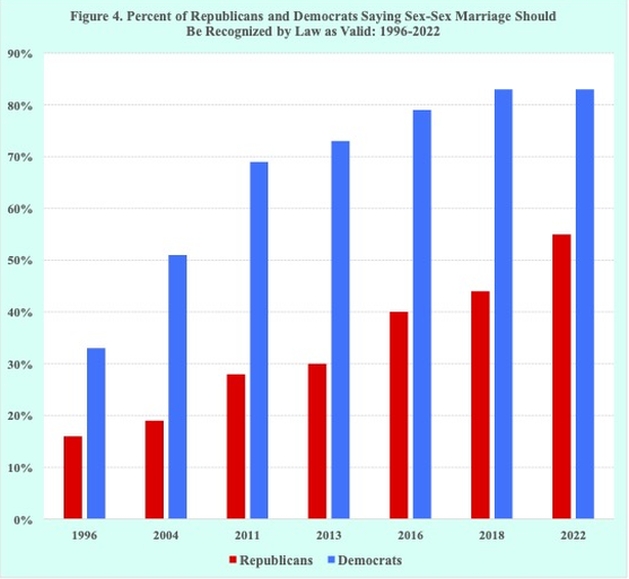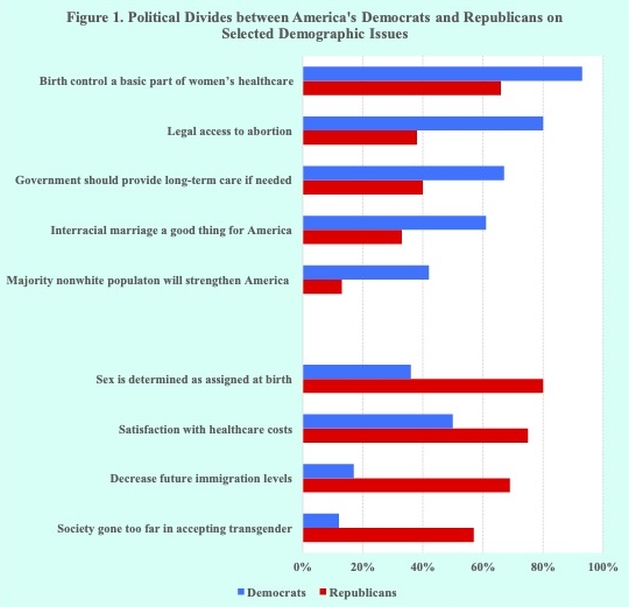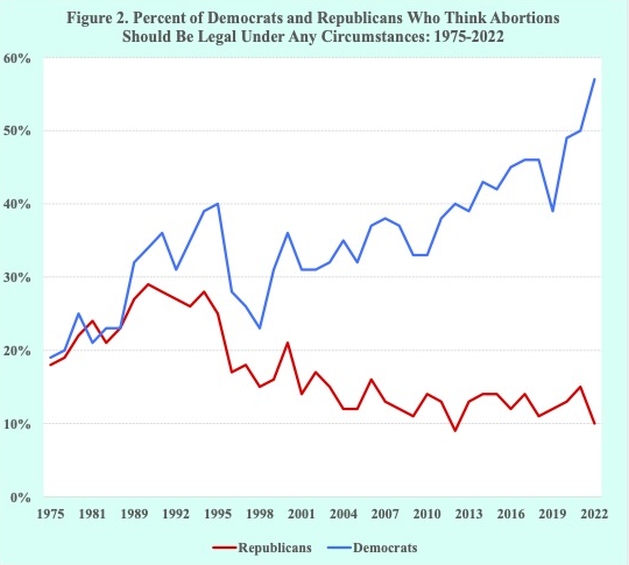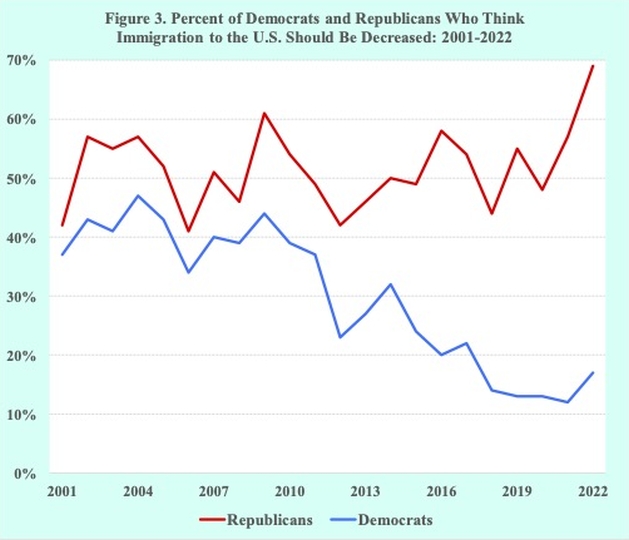Summary:
-
There are huge differences between Democrats and Republicans on almost every critical demographic issue, including population ageing, immigration, ethnic composition, mortality, and marriage (Figure 1).
-
Additionally, a recent study has shown that Republican-leaning counties have more early deaths than Democratic-leaning counties.
-
Democrats are more likely than Republicans to favour the changes in the ethnic makeup of the U.S. population.
-
Regarding same-sex marriage and interracial marriage, Democrats and Republicans have relative differences.
-
Democrats and Republicans have notable policy disagreements on population ageing that impact programmes.

It is valuable and appropriate to examine fundamental differences between America’s two major political parties on crucial demographic issues in light of the upcoming midterm elections in the United States and the implications of the results for domestic legislation and programmes, as well as the nation’s foreign policy.
There are huge differences between Democrats and Republicans on almost every critical demographic issue, including population ageing, immigration, ethnic composition, mortality, and marriage (Figure 1). The effects and ramifications of these divisions on present and upcoming public policies and initiatives are substantial.

These differences in crucial demographic issues, which have been made more partisan by the two major parties, are preventing the United States from developing economically, socially, and culturally. They are also fostering political polarisation and party hostility throughout the nation.
In terms of reproduction, the majority of Democrats support a woman’s right to an abortion, whilst the majority of Republicans do not. For instance, a March 2022 PEW national survey indicated that Democrats were more likely than Republicans to believe that abortion should be permitted in all or most situations, with an 80 percent to 38 percent difference.
Additionally, Gallup surveys show that since the late 1980s, Democrats and Republicans differ increasingly on the conditions that justify abortion. For instance, by 2022, 57 and 10 percent of Democrats and Republicans said that abortions should be permitted at any time (Figure 2).

Members of Congress and Supreme Court judges have comparable abortion stances, as their disagreement shows. While Congressional Republicans are opposed to such access and protections, Congressional Democrats mainly favour codifying access to abortion and protecting the ability to travel across state lines to have the surgery. Additionally, the recent Supreme Court ruling banning abortion rights illustrates the differences in the perspectives of the justices chosen by the Republican and Democrat administrations.
The vote on the recently passed House of Representatives bill, which deals with access to birth control methods, was mainly partisan. All Republicans opposed the law that tries to guarantee access to contraception except for eight. The birth control proposal is predicted to fall short in the Senate since most Republicans are likely to oppose it.
Democratic and Republican congressional leaders disagree on matters related to mortality and morbidity. The persistent Republican opposition to the Affordable Care Act, passed by Democrats more than ten years ago, is a striking illustration of this division.
Additionally, a recent study has shown that Republican-leaning counties have more early deaths than Democratic-leaning counties. The more considerable disparity in mortality outcomes is thought to have been caused by the policies chosen by Democratic-leaning states as opposed to Republican states. These measures include Medicaid expansion, health care accessibility, minimum wage laws, tobacco control, gun laws, and drug addiction treatment.
The disparity in mortality rates between Democrats and Republicans is also reflected in the early responses to the COVID-19 epidemic, which was elevated from a minor public health issue to a significant political one. While most Democratic politicians frequently emphasised mask use, social withdrawal, and similar preventive measures, many Republican leaders opposed such actions and downplayed the risks of the coronavirus.
Republicans and Democrats across the nation displayed behaviour and attitudes that represented their ideological divisions regarding the COVID-19 outbreak. Republican-leaning counties have had higher COVID-19 death rates than Democrat-leaning counties due to those attitudinal and behavioural disparities.
Republicans generally support lower immigration levels than Democrats do. For instance, a nationwide Gallup poll conducted in July 2022 revealed that 69 percent of Republicans and 17 percent of Democrats agreed that immigration to the United States should be reduced. Republicans are mostly to blame for the surge in support for lower immigration over the previous few years; their desire to do so has climbed by 21 points since June 2020, compared to an increase of 4 points among Democrats (Figure 3).

The former Republican administration promoted constructing a wall along the U.S.-Mexico border and restricting the granting of asylum applications to address immigration numbers. On the other hand, few Democratic leaders have supported building a border wall. The current Democratic administration is also doing its part to remove barriers to accepting asylum requests, including abolishing the previous administration’s “Remain in Mexico” policy.
The previous Republican administration wished to forbid including more than 11 million illegal immigrants in the country in the 2020 census. Undocumented immigrants were intentionally left out of the census count to avoid counting them when determining congressional representation. Contrarily, the current Democratic administration counts unauthorised immigrants when computing congressional representation and using census data.
There is a significant difference between the two major political parties on whether to provide amnesty to immigrants who are present illegally. While the majority of Democrats support giving illegal immigrants a path to citizenship, many Republicans are opposed to providing individuals who are living in the country illegally amnesty. According to a PEW survey conducted in August 2022, Democrats were twice as likely as Republicans to support a road to citizenship, with an approval rating of 80 percent vs 37 percent respectively.
Democrats are more likely than Republicans to favour the changes in the ethnic makeup of the U.S. population. For instance, in a nationwide PEW survey, Democrats were, at 42 percent each, three times more likely than Republicans to agree that a majority nonwhite population will promote American customs and values.
Regarding same-sex marriage and interracial marriage, Democrats and Republicans have relative differences. A majority of Democrats and a minority of Republicans, 61 and 33 percent, believe that the rise in interracial marriage is positive for the nation. Additionally, Democrats have consistently been more likely than Republicans to believe that same-sex marriages should be legally recognised as valid, with those percentages being 83 and 55% in 2022. (Figure 4).

Furthermore, 57 percent of Republicans, compared to 12 percent of Democrats, believe that society has accepted transgender persons excessively.
Democrats and Republicans have notable policy disagreements on population ageing that impact programmes. In general, Republican leaders have opposed Democrat-instituted entitlement programmes like Social Security and Medicare, favouring reliance on the private sector, individual freedom, and personal responsibility.
Republican leaders have suggested substituting private investment accounts and a voucher system for health insurance for these essential services for elderly Americans. Republicans have also suggested changing Social Security and Medicare from federal entitlement programmes to programmes that require annual Congressional approval as discretionary spending.
American politics differ similarly regarding providing the long-term care the elderly may require. According to a national PEW survey conducted in 2019, while two-thirds of Democrats believe that the government should bear the bulk of the cost of providing senior care, only 40% of Republicans share that opinion.
In conclusion, Democrats and Republicans today disagree significantly on practically every crucial demographic problem confronting the United States. The two parties are politicising these divisions, fostering political polarisation and party hostility nationwide, impeding American advancement in the twenty-first century and influencing domestic and foreign affairs.
Analysis by: Advocacy Unified Network

